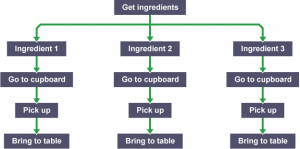Solutions that are not properly decomposed
- what kind of cake to bake
- what ingredients are needed, how much of each ingredient, and when to add it
- how many people the cake is for
- how long to bake the cake for
- what equipment is needed
A diagram of a further decomposition of ingredients would look like this:
At the moment, a diagram of the further decomposition of equipment would look like this:
The ‘Equipment’ part is not properly broken down (or decomposed). Therefore, if the solution – or algorithm – were created from this, baking the cake would run into problems. The algorithm would say what equipment is needed, but not how to use it, so a person could end up trying to use a knife to measure out the flour and a whisk to cut a lump of butter, for example. This would be wrong and would, of course, not work.
Ideally, then, ‘Equipment’ should be decomposed further, to state which equipment is needed and which ingredients each item is used with.
The problem occurred here because the problem of which equipment to use and which ingredients to use it with hadn’t been fully decomposed.
Solutions that are incomplete
- what kind of cake to bake
- what ingredients are needed, how much of each ingredient, and when to add it
- how many people the cake is for
- how long to bake the cake for
- what equipment is needed
However, this is incomplete – part of the problem has been left out. We still need to know:
- where to bake the cake
- what temperature to bake the cake at
Therefore, if this information was used to create the solution, the algorithm would say how long the cake should be baked for but it would not state that the cake should be placed in the oven, or the temperature that the oven should be. Even if the cake made it to the oven, it could end up undercooked or burnt to a cinder.
Very important factors have been left out, so the chances of making a great cake are slim.
The problem occurred here because placing the cake in the oven and specifying the oven temperature had not been included, making the solution incomplete.
Solutions that are inefficient
It would be more efficient to fetch all the ingredients in one go, and the program would be shorter as a result:
The solution is now simpler and more efficient, and has reduced from nine steps to five.
The problem occurred here because some steps were repeated unnecessarily, making the solution inefficient and overly long.
Solutions that do not meet the original design criteria
- what kind of cake to bake
- what ingredients are needed, how much of each ingredient, and when to add it
- how many people the cake is for
- how long to bake the cake for
- what equipment is needed
The first point considers what kind of cake to bake. Often, when devising solutions to problems, a specification for the design is given. For example, the cake may have to be a chocolate cake, which is still quite general, or a chocolate fudge cake with chocolate icing and flakes on top, which is more specific.
To meet the design criteria, it is important to ensure that the exactly right kind of cake is baked. Otherwise the solution may not be fit for purpose.
The problem occurred here because the solution did not meet the original design criteria – it was not exactly what was requested.





